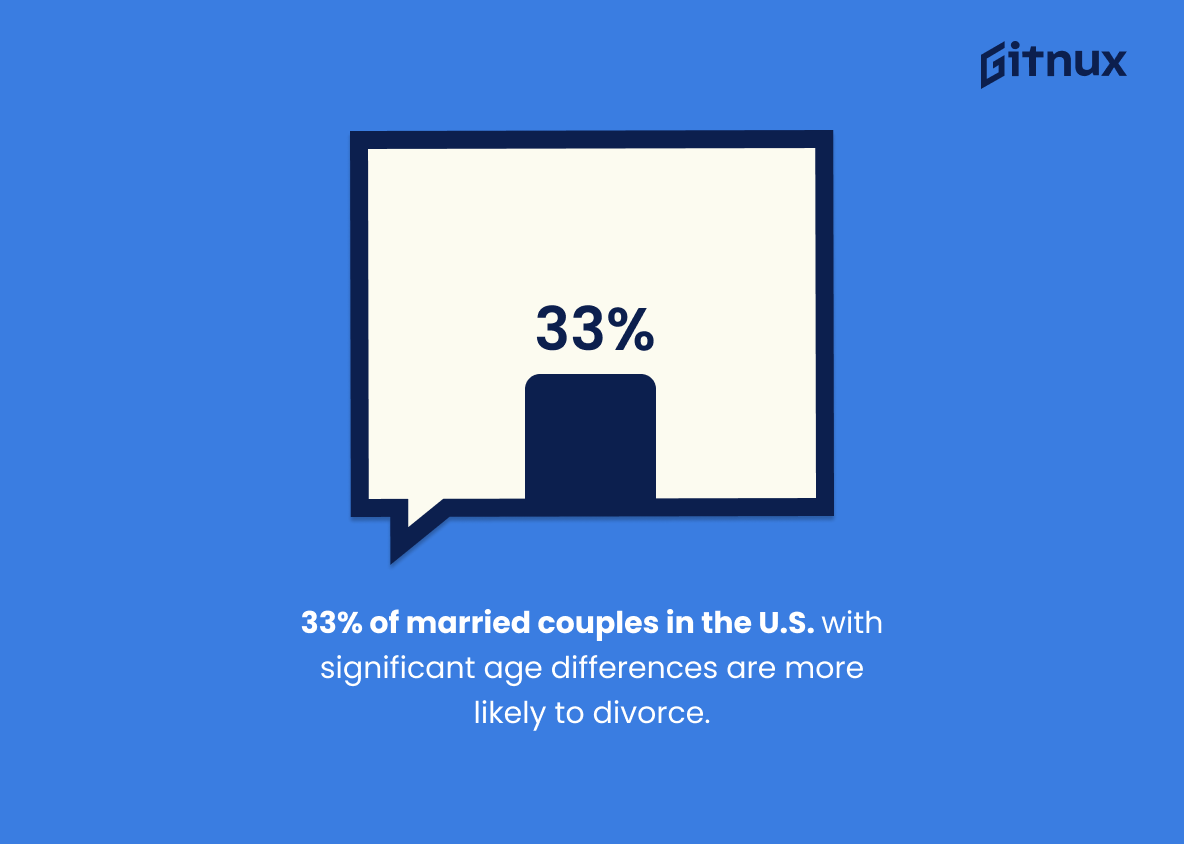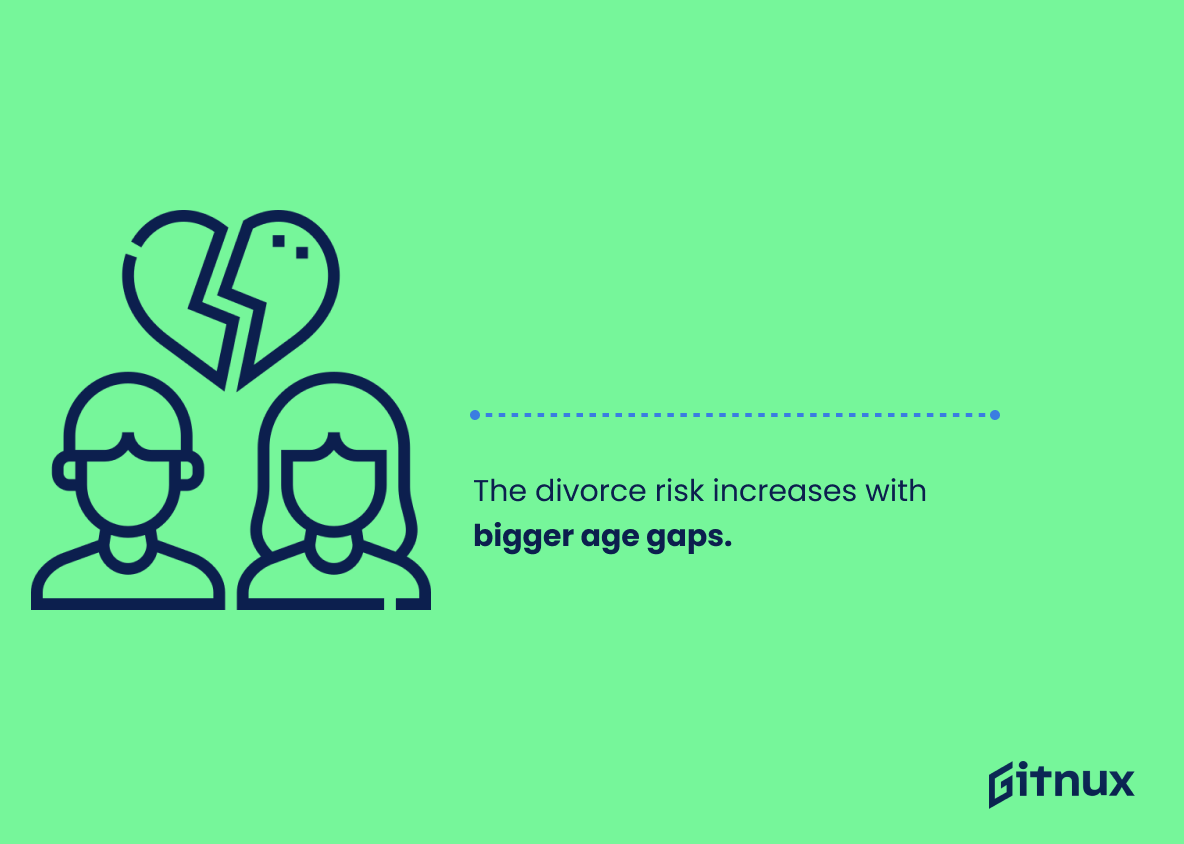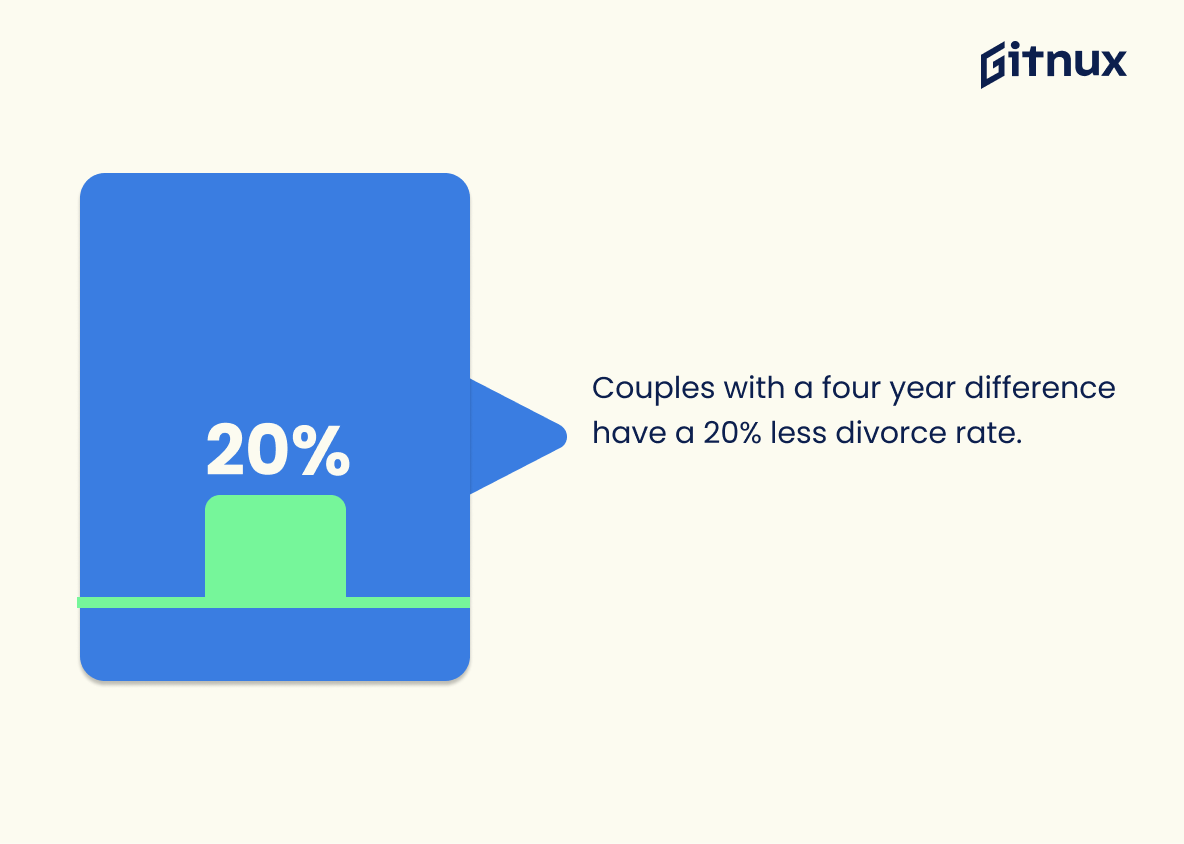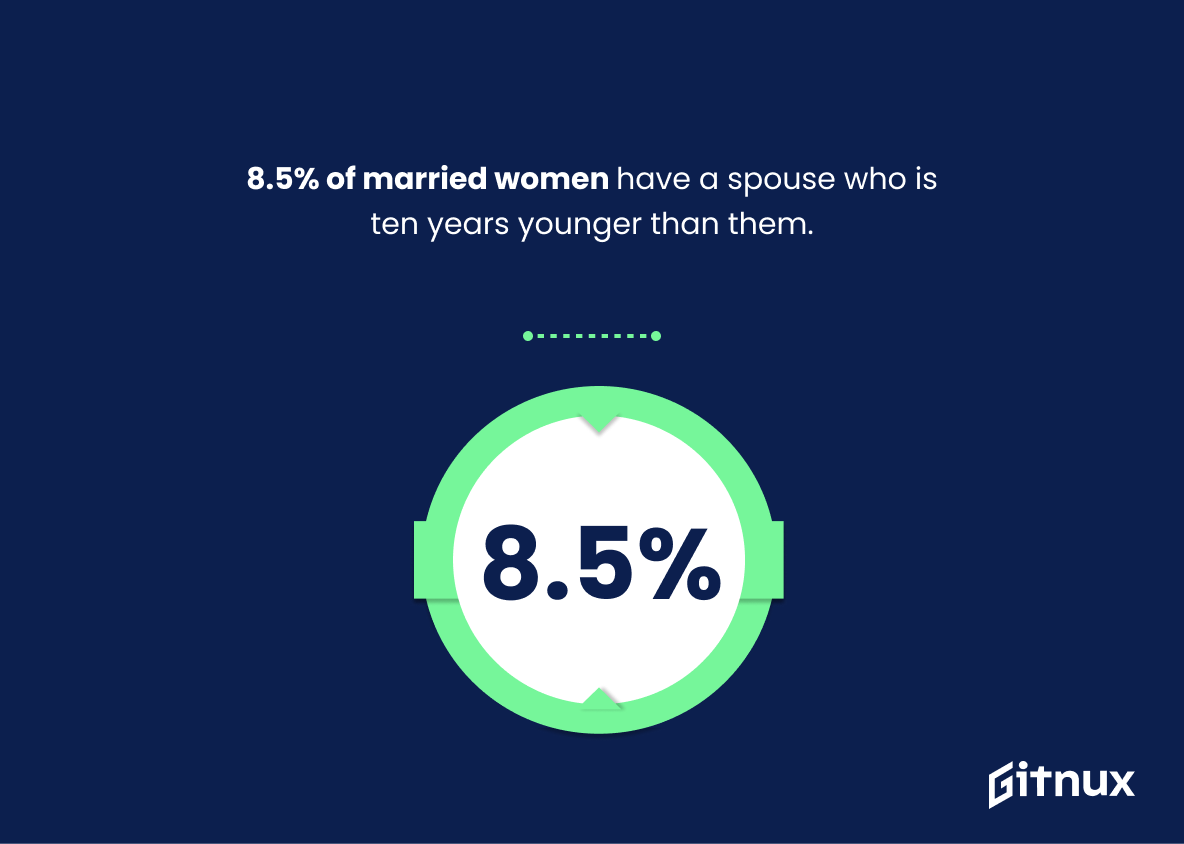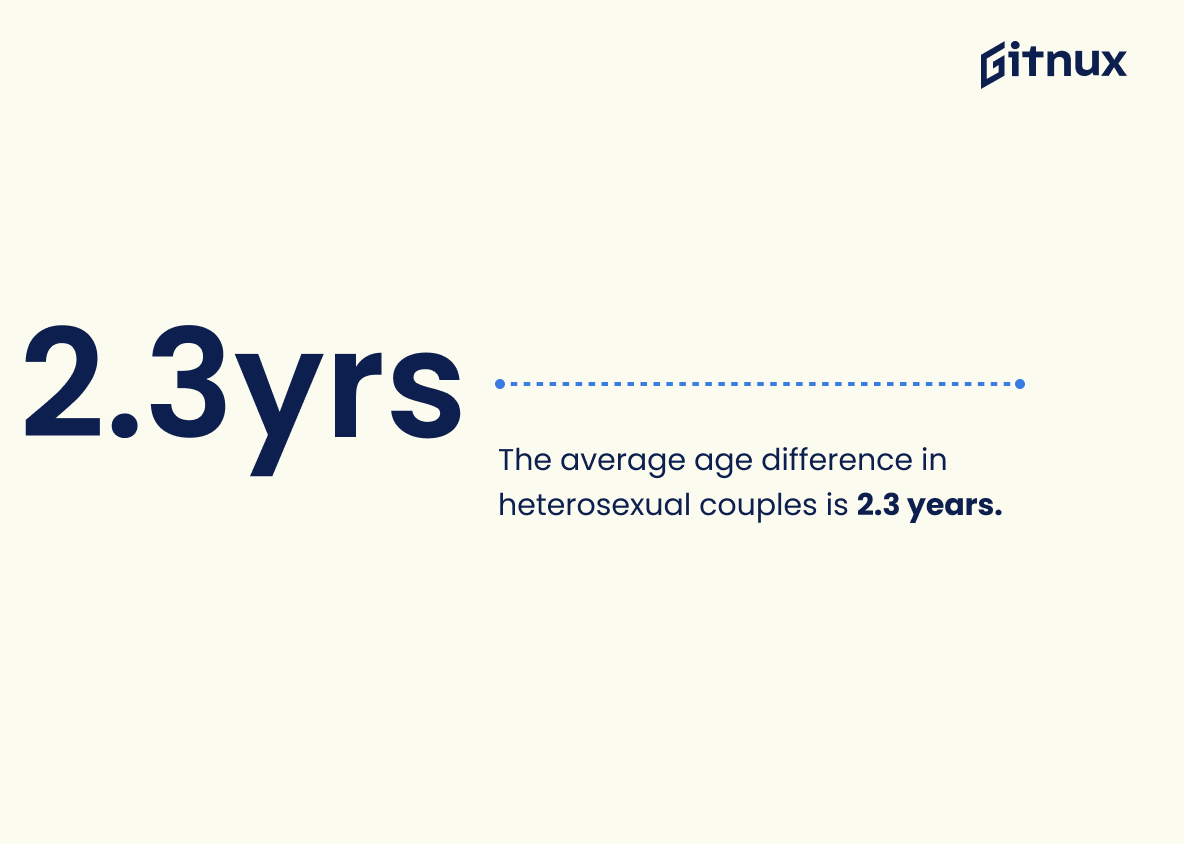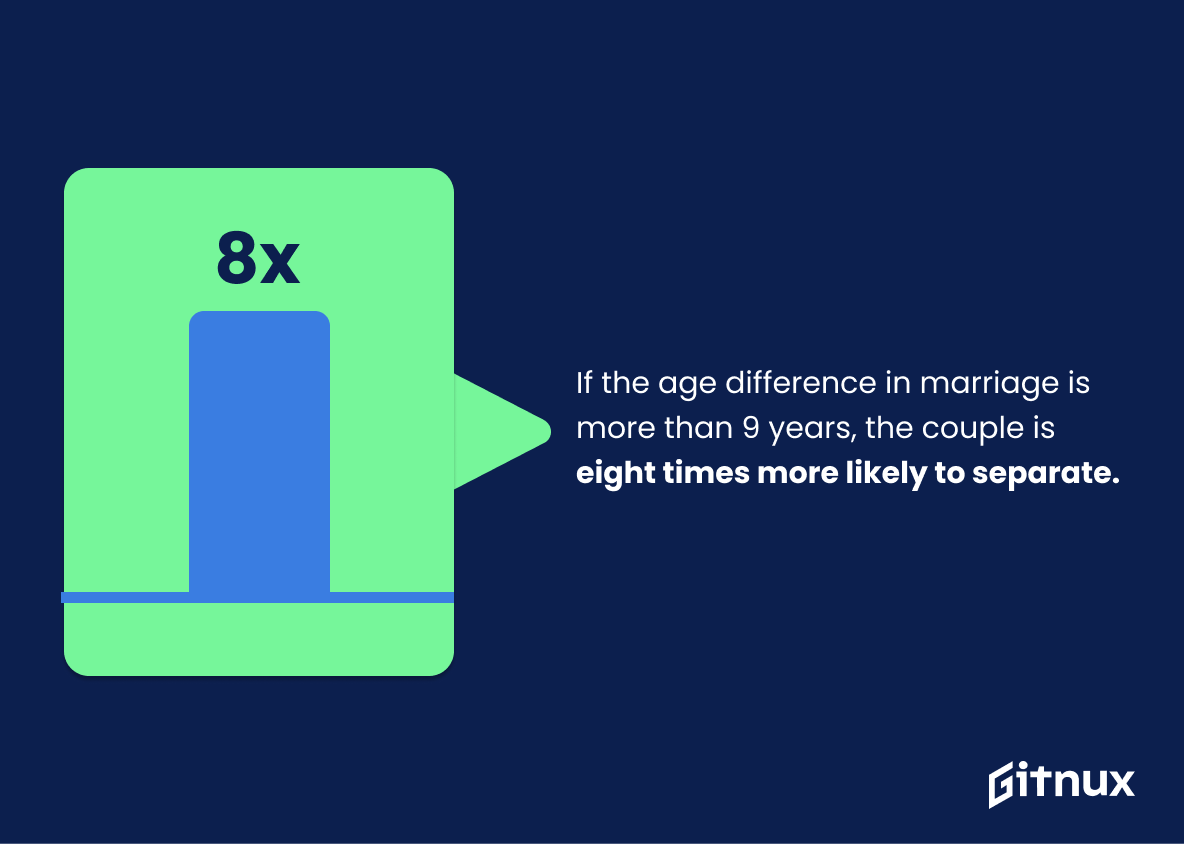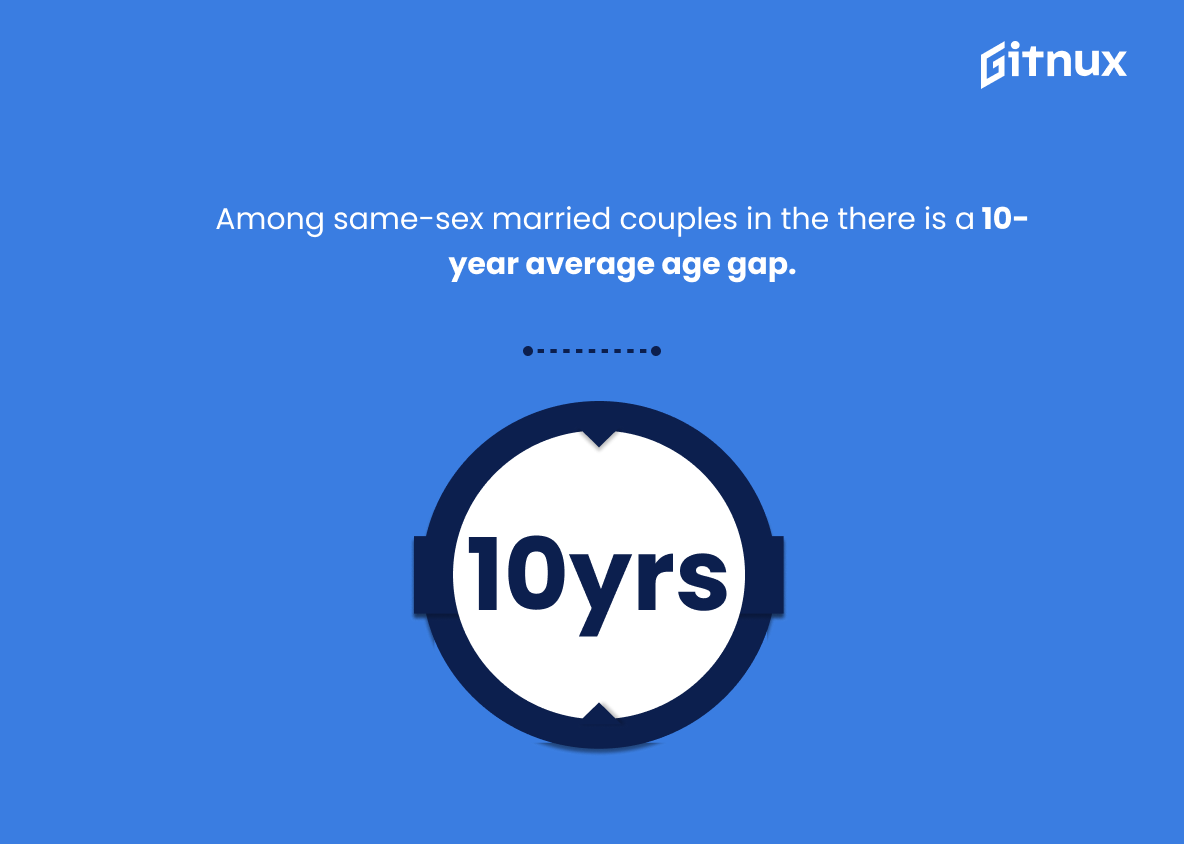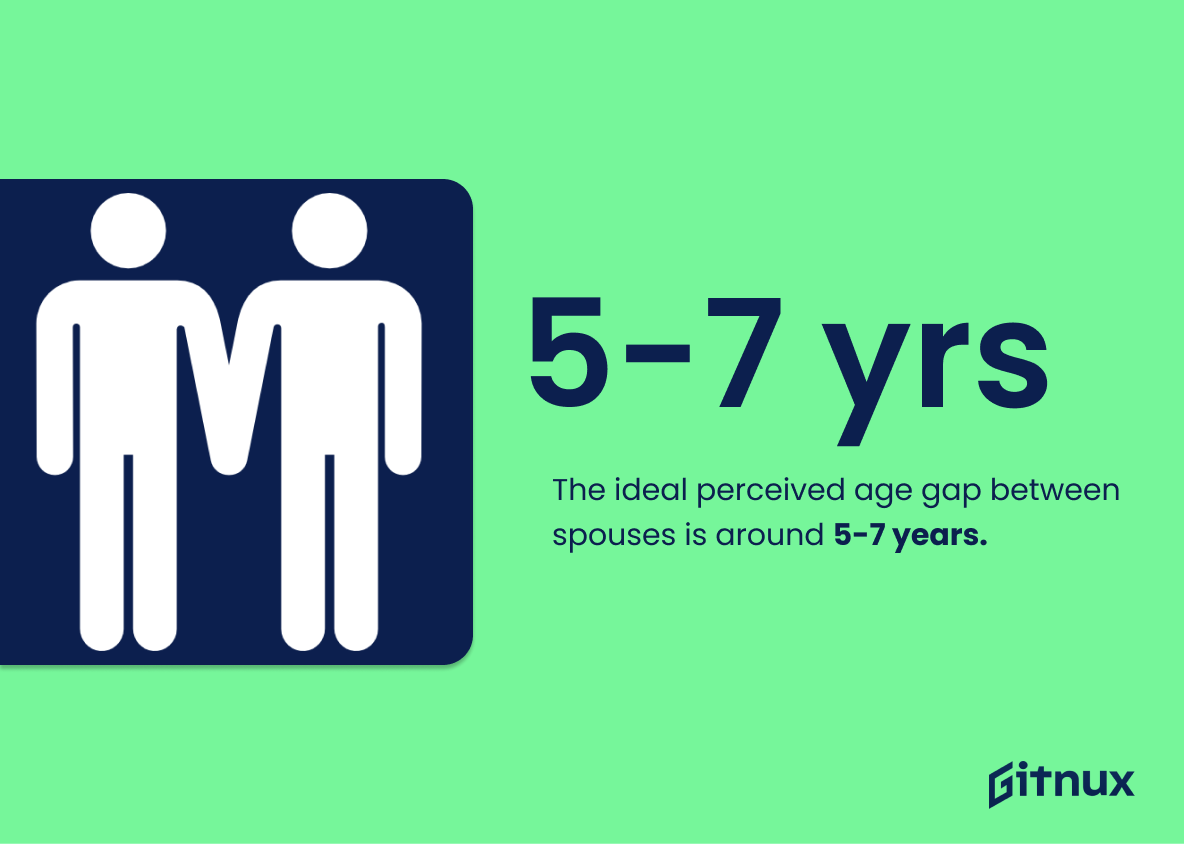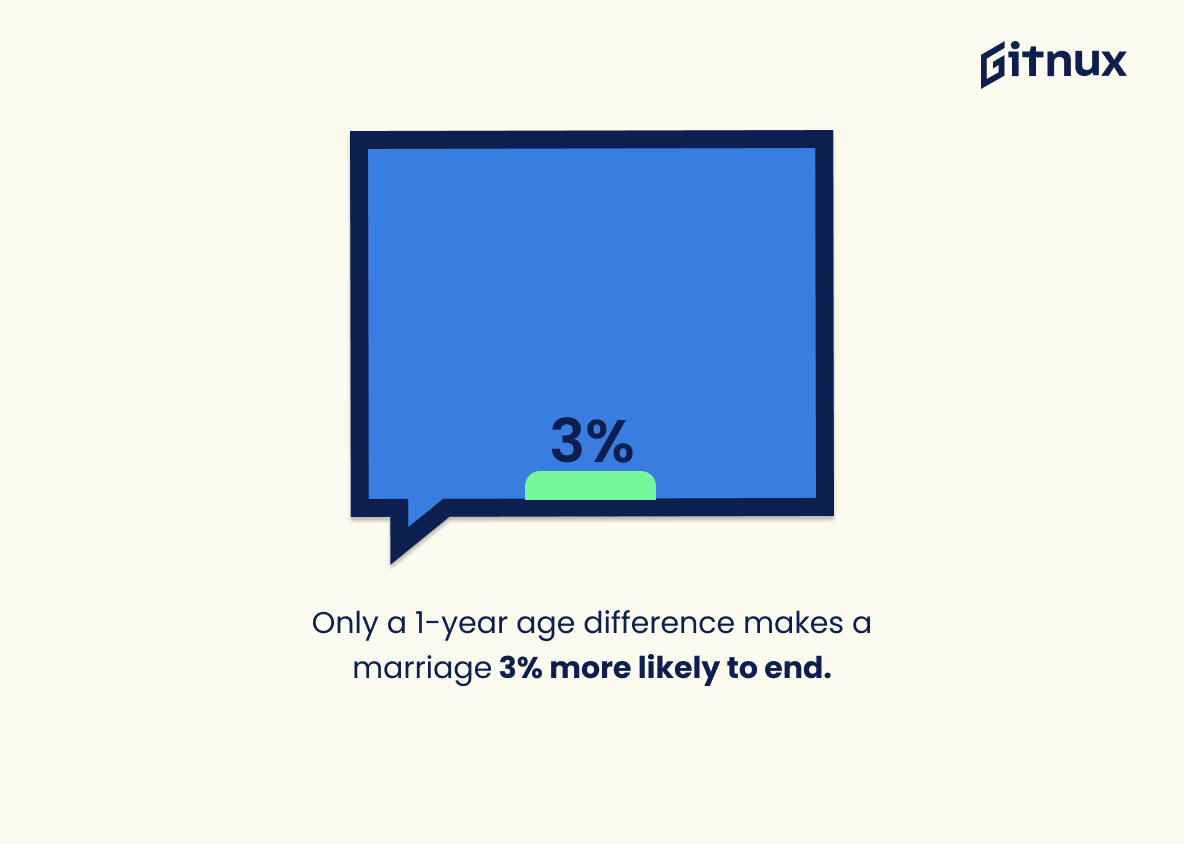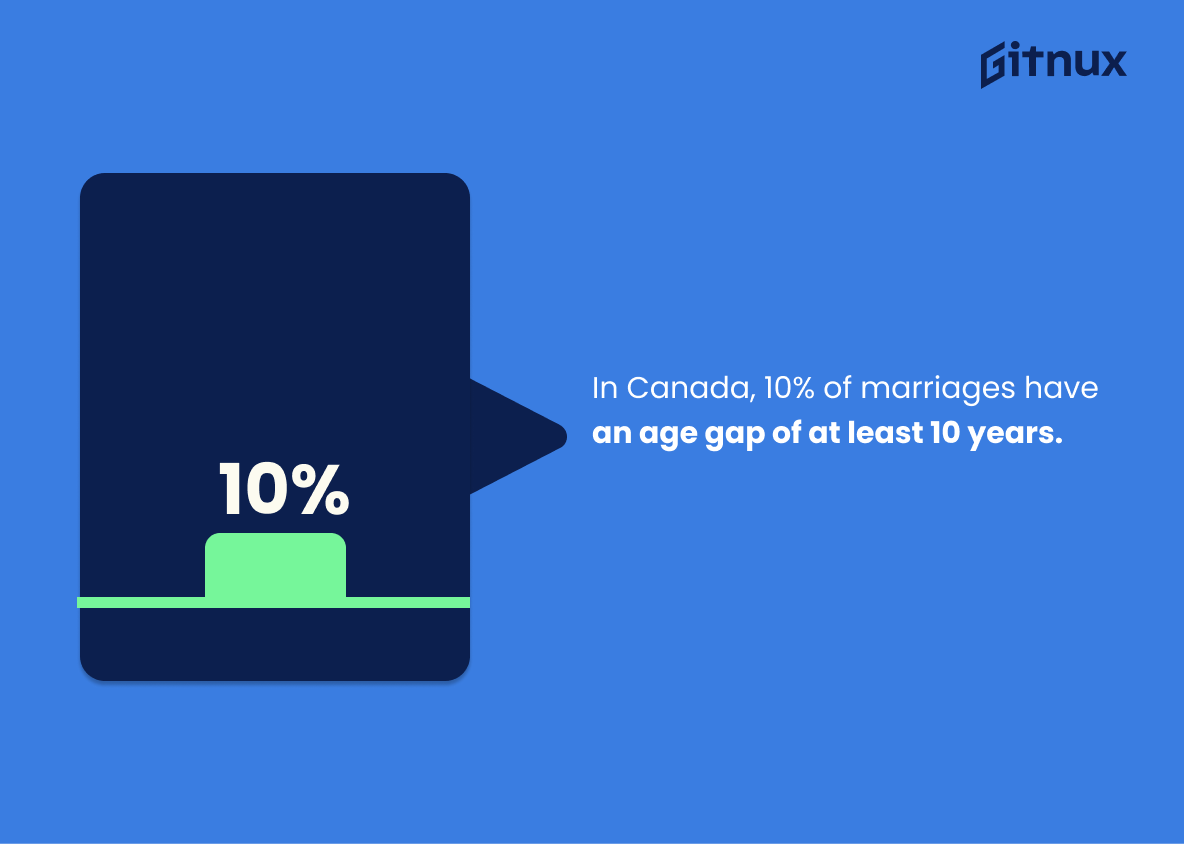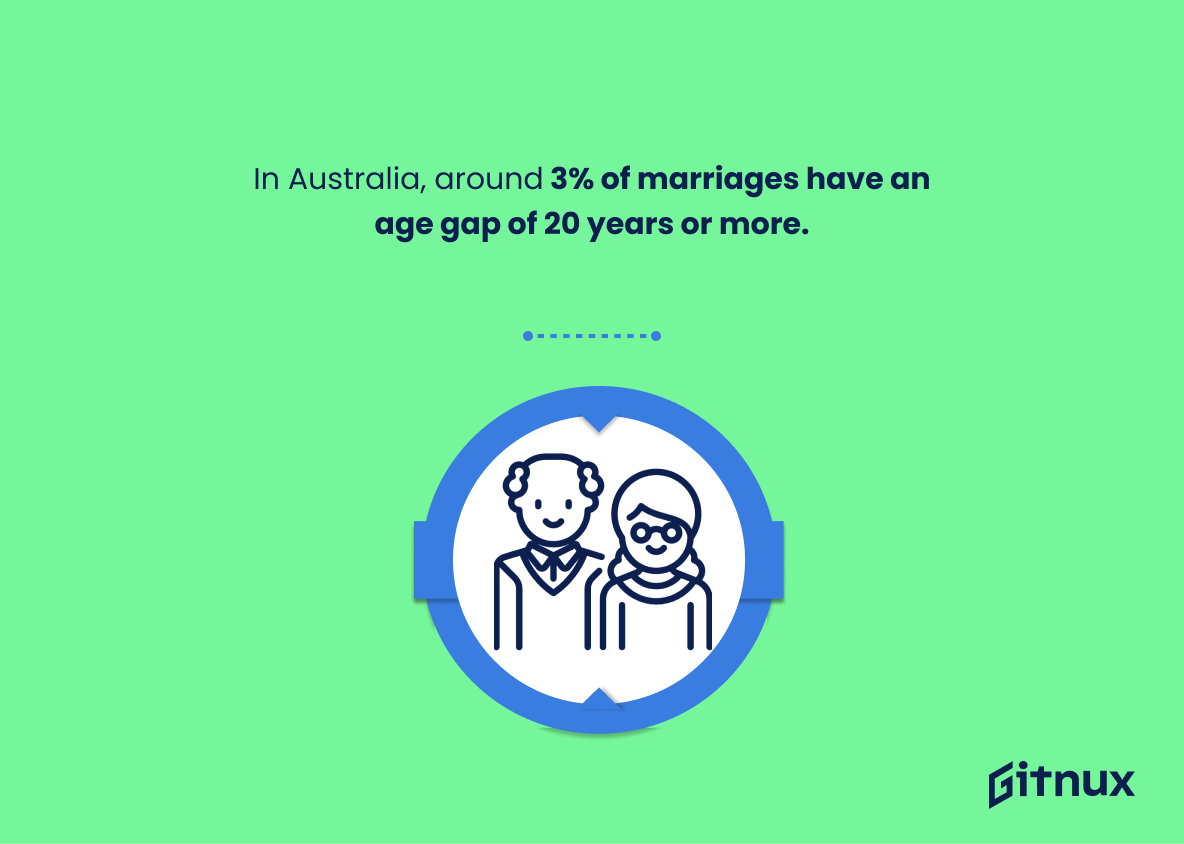From celebrities to ordinary folk, stories of age gap marriages continue to make headlines, inciting a diverse array of opinions. Often, these unions raise intriguing questions about love, compatibility, and longevity. But what do the actual statistics say about age gap marriages?
This blog post delves into the fascinating world of age gap marriage statistics, analyzing trends, success rates, and societal implications. Whether you’re just curious or looking to understand this phenomenon better, our data-driven exploration promises to shed new light on the often-debated dynamics of age gap marriages.
The Latest Age Gap Marriage Statistics Unveiled
The U.S. sees around 18% of marriages featuring an age gap of at least two years, with the majority of these being between an older man and a younger woman.
Presenting this compelling statistic, underscoring that nearly one in five U.S. marriages exhibits an age gap of two years or more, invokes a vibrant picture of the complex dynamics of American marital landscape. Highlighted within is the recurrent theme of unions where men are generally older than their female counterparts.
This revelation, grounded in empirical data, injects substance into our understanding of age gap marriage trends, animating dialogue about societal norms, cultural expectations, and intergenerational relationships in the context of our blog on Age Gap Marriage Statistics.
33% of married couples in the U.S. with significant age differences are more likely to divorce.
When crafting a narrative about Age Gap Marriage Statistics, this particular fact – a surprising 33% of married couples in the U.S with considerable age gaps tend to veer towards dissolution – has undeniable relevance. It tells a tale of caution, an unmistakable ripple effect of age differences that emerge later in the relationship. These divorces are not just cold, hard numbers, but narratives shedding light on challenges often unseen at marital onset.
As readers wade through the intriguing waters of age gap marriages, arming them with this knowledge helps them grasp the realistic challenges such liaisons may encounter. Thus, can navigate their understanding of age disparate marriages with a more informed and nuanced lens.
In the UK, marriages are most successful when the age gap is just one year, with the divorce risk increases with bigger age gaps.
The elucidation of this statistic serves as the heart-throb of our exploration into Age Gap Marriage Statistics; it essentially paints a vivid picture of the landscape of marital success in the UK. Through its lens, we perceive a compelling pattern: The closer in age couples are the higher the likelihood of their marital longevity, thereby inferring that disparity in age may pose challenges that accentuate the risk of divorce.
This intriguing relationship between age difference and divorce rates sets a substantial foundation for our blog post, inviting readers to delve into the depths of how and why age gaps can significantly influence marriage outcomes.
The ideal age gap for a successful marriage is thought to be around four years, as couples with this age difference have a 20% less divorce rate.
Bringing this particular statistic to the forefront is like shining a spotlight on the intriguing tango of time and love. Through the lens of statistical analysis, we find intriguing nuggets of truth hidden beneath the surface of age gap marriage dynamics. Highlighted amidst these nuggets, we see that an age gap of about four years is credited with a 20% decrease in divorce rates.
This unexpected insight imparts a critical understanding for anyone seeking perspective on the complexities of age gap marriages. As such, it doesn’t just act as a beacon guiding our exploration in the realm of such marriages, but it also allows readers to deep dive into the potential impact of age disparities on marital success. From age-oriented advice for prospective partners to policy-making perspectives for relationship counsellors, an insight like this elevates the significance of our post about Age Gap Marriage Statistics to a whole new level.
Globally, 8.5% of married women have a spouse who is ten years younger than them.
Delving into the fascinating world of Age Gap Marriage Statistics, we stumble upon a gem of information. It appears that globally, 8.5% of wedded women have taken the enchanting road less traveled, choosing lifelong companions who are a decade their junior. This intriguing fact provides a statistical underpinning for the discussion, painting a vivid picture of the delicate dance of love that moves beyond the societal expectations of age.
Furthermore, it guides us into an expansive exploration of modern relationship dynamics and socio-cultural shifts, enriching our understanding of the diverse tapestry of marital unions worldwide. This certainly throws in a cool breeze of perspective into the fiery debate about age and marital bliss, doesn’t it?
In 6% of married women, their spouses are at least 10 years younger.
Peering through the statistical lens into matrimonial age gaps, it’s fascinating to note that 6% of married women share their lives with spouses at least a decade their junior. This intriguing piece of data stands as a testament to shifting societal norms, challenging traditional marriage conventions where the male partner is typically older.
Acting as a conversation starter, this statistic invites us to delve deeper into the diverse dynamics of ‘Age Gap Marriages’ and explore the impact on factors such as marital satisfaction, life expectancy, child rearing, and societal acceptance, thereby enriching the discourse of the blog post.
According to the U.S. Census Bureau, 5.5% of all married couples in the U.S. have a spouse who is at least ten years older.
Unraveling the complexities of marital dynamics, a poignant revelation from the U.S. Census Bureau presents itself against the backdrop of the age-gap narrative: a surprising 5.5% of all married couples across the U.S. have a spouse who is at least ten years older. This percentage is not just a number, it’s a subtlety whispering ‘age is just a number’ from the rooftops of American homes.
The statistic, striking in its singularity, breathes vitality into the textured tapestry of age-gap marriage statistics giving it depth, scope, and making a connection between numbers and societal behavior. So, even amidst the predictable ordinariness, the unexpected thrives – and that’s the beauty of statistics.
According to 2012 statistics, the average age difference in heterosexual couples is 2.3 years.
When exploring the realm of age gap marriages, this particular 2012 statistic acts as a cornerstone for the entire discourse. The stated average age difference of 2.3 years in heterosexual couples serves as a critical yardstick to measure shifts in societal and cultural trends, relationship dynamics, and equilibrium points in marital age differences.
It underscores a standard or prevailing status quo in human relationships that further offers an incisive comparative tool when assessing the evolving nature of age gap marriages. It’s akin to lifting the veil on the intricate reality of modern marriage, splashing a hue of understanding onto the broad canvas of marital age disparities.
A study has shown that if the age difference in marriage is more than 9 years, the couple is eight times more likely to separate.
Delving into the fascinating world of age gap marriage statistics, one particular study casts a profound light on the longevity of such relationships. If the age difference stretches beyond nine years, the odds of uncoupling amplify by a startling factor of eight. This intriguing measurement provides invaluable insight for those contemplating a marriage where a significant age gap is a factor.
It underscores the potential challenges that may lie ahead, prompting couples to explore the depths of their compatibility beyond the numerical gap in their birthing years. Such an analysis also equips marriage counselors and therapists with a data-backed perspective to guide their clients more effectively. Therefore, the potency of this statistic is an indispensable tool for layered understanding and insightful conversations in our blog on age gap marriage statistics.
Among same-sex married couples in the U.S., a Q.D. University study reveals a 10-year average age gap.
Delving into the realm of age gap marriages, this Q.D. University study presents an invigorating insight featuring same-sex couples in the U.S. Showcasing a decade-long age difference, this statistic creates a robust anchor for the conversation around age divergences in marriages.
This illuminated dimension sets the stage for an enriching exploration of the age disparity amongst same-sex couples, serving as a testament to the diversity in their relationships. Additionally, this statistic prompts a captivating examination of cultural dynamics, socio-economic factors, and potential challenges associated with sizeable age gaps in these marriages.
Data suggests that in India, the ideal perceived age gap between spouses is around 5-7 years.
In a blog post shedding light on Age Gap Marriage Statistics, illuminating such a statistic serves as a captivating cornerstone. Just imagine, in the grandeur of Indian culture, where marriage weaves together not just two people but two families, the perceived ideal age gap between spouses ranges from a notable 5-7 years. It enlivens the conversation, offers intriguing cultural insights, and provides a valuable cornerstone for comparisons with other countries or cultures.
This specific data nugget fortifies the blog’s credibility, enhances reader engagement, and meshes effectively with the overarching narrative on the age gap in marriages across the globe. With its help, readers can perceive patterns, discern norms, and unearth intriguing societal trends. It’s just a small numeric piece, yet it’s crucial in sculpting the bigger portrait of age gap marriage dynamics.
Only a 1-year age difference makes a marriage 3% more likely to end, which increases by 18% for a 5-year age gap and 39% for a 10-year difference.
This fascinating statistic serves as the backbone to the discussion on age gap marriages, shedding some thought-provoking light on the correlation between age differences and marital success rates. By quantifying the risk, it drastically illustrates how each year of the age gap inflates the probability of a marriage ending, reaching a shocking 39% increase for a 10-year age difference.
Embedding this data in a blog post on Age Gap Marriage Statistics not only substantiates the nuances of these relationships but also anchors the discussion in measurable, tangible evidence. Therefore, drawing attention to such a statistic underscores the importance of considering age differences while contemplating matrimonial choices, thereby enriching readers’ understanding of age gap marital dynamics.
In Australia, the median age gap between partners in all marriages was 2.9 years.
Integrating this intriguing piece of statistic adds a mesmerizing depth to our blog post on Age Gap Marriage Statistics. It throws light on how Australian marriages display an average trend where one partner is typically around three years older than the other. This serves as a crucial indicator for detecting underlying cultural, societal, and possibly personal preferences that shape the norms of marriage in Australia.
Moreover, it helps challenge or validate widespread assumptions on the suitability of age differences between spouses and adds substantive evidence to compare and contrast with other global regions. Gleaning insights from this median age gap can also catalyze discussions on its potential ripple effects on other aspects of marital dynamics such as relationship satisfaction, longevity, or stress levels.
In Canada, 10% of marriages have an age gap of at least 10 years.
Being aware that one out of every ten marriages in Canada features a 10-year age disparity offers an intriguing perspective in a blog post discussing Age Gap Marriage Statistics. This piece of data plays a vital role in dissecting and understanding the wider societal trends and cultural norms associated with matrimony in Canada.
It helps to set the backdrop against which evolving societal attitudes towards age differences in marriages can be interpreted, illustratively suggesting that marital bonds aren’t strictly confined to similar age groups. Furthermore, it implies potential sociological, economic, and psychological factors worth exploring that motivate these marriages, contributing to a richer, more nuanced understanding of age-gap relationships in modern society.
In Australia, around 3% of marriages have an age gap of 20 years or more.
Featured prominently within Australia’s landscape of matrimonial unions, the statistic of 3% of marriages that bear an age difference of 20 years or more unveils an intriguing narrative on age dynamics in contemporary relationships. This numerical revelation imprints a vital inkblot on the canvas of the broad analysis on Age Gap Marriages, offering readers a tangible perspective into the frequency and popularity of such unions in the Australian demographic scene.
In essence, this statistic stimulates thought-provoking discourse around societal norms, generational diversity, and changing definitions of love and compatibility, rendering it a key cog in the machinery of our blog post about Age Gap Marriage Statistics.
According to a study, a 5-year age difference makes couples 18% more likely to divorce, and a step-up to a 30-year age gap makes the likelihood of divorce 172%.
Peeling back the layers of a marital bond, this statistic offers valuable insights that could be material in comprehending the nuanced impact of age differences on relationship stability. In the mosaic of Age Gap Marriage Statistics, these figures stand out, suggesting a fascinating, and possibly intimidating, correlation between the expanding age gap and rising odds of divorce.
Fanning the flames of intrigue, they underline the almost twofold jump in divorce likelihood faced by couples with a striking 30-year age difference compared to a more modest five-year gap. If navigating the turbulent seas of matrimony wasn’t challenging enough, these numbers add another level of complexity, underscoring the role age differences play in steering marriages towards tranquility or tempestuousness.
In South Korea, as per data of 2020, married couples with an age gap of more than nine years accounted for around 10.3 percent.
Embarking on the journey of marital bliss, couples often weigh in on various factors, one vital and much-debated one being the age gap. However, believing that love knows no bounds, many choose to overlook the years that separate them. This notion finds credence in the 2020 South Korean data, revealing that approximately 10.3 percent of married couples have an age difference exceeding nine years.
The significance of this percentage lies in the understanding it offers regarding the perception and acceptance of age-difference marriages. For those advocating for or against age-gap marriages, this statistic delivers a tangible figure to picture the proportion of such unions in a country’s population.
Moreover, this information contains potential to highlight the impact of age disparities on marital longevity and satisfaction, influencing societal norms and expectations, thereby stirring a vivid discussion on the subject matter. It is a perfect testament to the time-honored adage, “age is just a number,” when it comes to love and marriage.
In China, according to a 2011 statistics, the mean age difference in couples was about 2.8 years.
Delving into the realm of Age Gap Marriage Statistics, we turn to the intriguing statistic from 2011 – a 2.8 year mean difference age gap in Chinese couples. This salient fact offers an enlightening perspective and adds depth to our understanding. First, it provides a benchmark for considering average age disparities between partners in different regions of the world.
It allows readers to comprehend intergenerational trends and cultural preferences towards age gaps in relationships, which may significantly differ from country to country. Moreover, it could reveal potential influences of societal norms and traditions on the selection of partners. As a cornerstone for comparison, this statistic punctuates the cross-cultural dialogue on conceptualizations of ideal partner age differences.
Data from Eurostat shows that in European countries, 2-3 years was the typical age difference in married couples.
Illuminating the patterns of age difference in married couples across European countries, the data from Eurostat reveals a fascinating norm of a 2-3 years gap. An insightful perspective into Age Gap Marriage Statistics, this piece of information crucially provides a cornerstone for comparisons and contrasts within the blog post. It lays down a foundation enabling readers to comprehend the magnitude and implications of age variance in both the local and global marital landscapes.
Furthermore, it paves way for exploration of linkages between such trends and socio-cultural, psychological, or economic dimensions of marriage. Thus, this statistic emerges as a narrative fulcrum around which a comprehensive understanding of age gap marriage statistics can genuinely revolve.
Conclusion
Age gap marriages are not an uncommon occurrence, and the data substantiates this fact. While age may just be a number in love, it’s significant to understand how these statistics can shape our societal norms and expectations. Age gap marriages come with their unique joys and challenges alike. The statistics bear witness to prevailing trends and give us insightful knowledge, but it’s essential to remember that each relationship is individual, and numbers can’t define them completely.
Everyone’s love story is unique irrespective of age. However, understanding these marriage statistics can be eye-opening and contribute to a broader understanding of modern relationships. Remember, compatibility, understanding, respect and love form the foundation of a successful marriage, whether it’s an age-gap marriage or otherwise.
References
0. – https://www.www.businessinsider.com
1. – https://www.www.pewresearch.org
2. – https://www.www.sciencedaily.com
3. – https://www.www.independent.co.uk
4. – https://www.www.census.gov
5. – https://www.www.jstor.org
6. – https://www.time.com
7. – https://www.www.statista.com
8. – https://www.www.theaustralian.com.au
9. – https://www.qz.com
10. – https://www.ec.europa.eu
11. – https://www.www.abs.gov.au
12. – https://www.www.ncbi.nlm.nih.gov
13. – https://www.www.theatlantic.com
14. – https://www.scholar.google.com
15. – https://www.www.express.co.uk
16. – https://www.www.bbc.com

